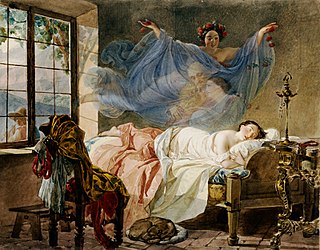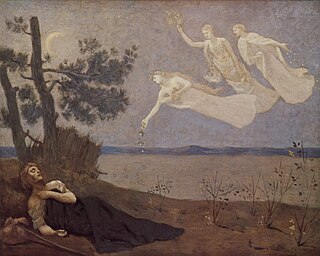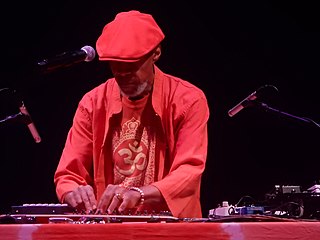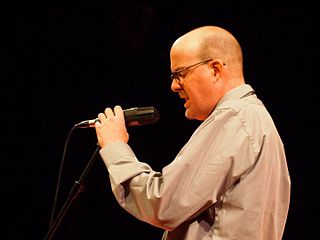Related Research Articles

A lucid dream is a type of dream where the dreamer becomes aware that they are dreaming. During a lucid dream, the dreamer may gain some amount of control over the dream characters, narrative, or environment; however, this is not actually necessary for a dream to be described as lucid. Lucid dreaming has been studied and reported for many years. Prominent figures from ancient to modern times have been fascinated by lucid dreams and have sought ways to better understand their causes and purpose. Many different theories have emerged as a result of scientific research on the subject and have even been shown in pop culture. Further developments in psychological research have pointed to ways in which this form of dreaming may be utilized as a form of sleep therapy.

A dream is a succession of images, ideas, emotions, and sensations that usually occur involuntarily in the mind during certain stages of sleep. Humans spend about two hours dreaming per night, and each dream lasts around 5 to 20 minutes.
Psychoanalytic literary criticism is literary criticism or literary theory which, in method, concept, or form, is influenced by the tradition of psychoanalysis begun by Sigmund Freud.
In literary criticism, stream of consciousness is a narrative mode or method that attempts "to depict the multitudinous thoughts and feelings which pass through the mind" of a narrator. The term was coined by Alexander Bain in 1855 in the first edition of The Senses and the Intellect, when he wrote, "The concurrence of Sensations in one common stream of consciousness enables those of different senses to be associated as readily as the sensations of the same sense" (p. 359). But it is commonly credited to William James who used it in 1890 in his The Principles of Psychology. In 1918, the novelist May Sinclair (1863–1946) first applied the term stream of consciousness, in a literary context, when discussing Dorothy Richardson's novels. Pointed Roofs (1915), the first work in Richardson's series of 13 semi-autobiographical novels titled Pilgrimage, is the first complete stream-of-consciousness novel published in English. However, in 1934, Richardson comments that "Proust, James Joyce, Virginia Woolf & D.R. ... were all using 'the new method', though very differently, simultaneously". There were, however, many earlier precursors and the technique is still used by contemporary writers.

"To be, or not to be" is the opening phrase of a soliloquy given by Prince Hamlet in the so-called "nunnery scene" of William Shakespeare's play Hamlet, Act 3, Scene 1. In the speech, Hamlet contemplates death and suicide, bemoaning the pain and unfairness of life but acknowledging that the alternative might be worse. The opening line is one of the most widely known and quoted lines in modern English, and the soliloquy has been referenced in innumerable works of theatre, literature, and music.

Dream art is any form of art that is directly based on a material from one's dreams, or a material that resembles dreams, but not directly based on them.

Speech balloons are a graphic convention used most commonly in comic books, comics, and cartoons to allow words to be understood as representing the speech or thoughts of a given character in the comic. Often, a formal distinction is made between the balloon that indicates thoughts and the one that indicates words spoken aloud; the balloon that conveys thoughts is often referred to as a thought bubble or conversation cloud.

Laraaji is an American multi-instrumentalist specializing in piano, zither and mbira. His albums include the 1980 release Ambient 3: Day of Radiance, produced by Brian Eno as part of his Ambient series.
Somniloquy, commonly referred to as sleep-talking, is a parasomnia that refers to talking aloud while asleep. It can range from simple mumbling sounds to loud shouts and long, frequently inarticulate speeches, and can occur many times during a sleep cycle.

Philosophy and literature involves the literary treatment of philosophers and philosophical themes, and the philosophical treatment of issues raised by literature.
Literary modernism, or modernist literature, originated in the late 19th and early 20th centuries, mainly in Europe and North America, and is characterized by a self-conscious break with traditional ways of writing, in both poetry and prose fiction writing. Modernism experimented with literary form and expression, as exemplified by Ezra Pound's maxim to "Make it new." This literary movement was driven by a conscious desire to overturn traditional modes of representation and express the new sensibilities of their time. The horrors of the First World War saw the prevailing assumptions about society reassessed, and much modernist writing engages with the technological advances and societal changes of modernity moving into the 20th century.
A soundtrack album is any album that incorporates music directly recorded from the soundtrack of a particular feature film or television show. The first such album to be commercially released was Walt Disney's Snow White and the Seven Dwarfs, the soundtrack to the film of the same name, in 1938. The first soundtrack album of a film's orchestral score was that for Alexander Korda's 1942 film Rudyard Kipling's Jungle Book, composed by Miklós Rózsa.
Archetypal literary criticism is a type of analytical theory that interprets a text by focusing on recurring myths and archetypes in the narrative, symbols, images, and character types in literary works. As an acknowledged form of literary criticism, it dates back to 1934 when Classical scholar Maud Bodkin published Archetypal Patterns in Poetry.
Rhetorical modes describe the variety, conventions, and purposes of the major kinds of language-based communication, particularly writing and speaking. Four of the most common rhetorical modes are narration, description, exposition, and argumentation. The first codification of these rhetorical modes was by Samuel P. Newman in A Practical System of Rhetoric in 1827.
An internal monologue, also called self-talk, inner speech, inner discourse or internal discourse, is a person's inner voice which provides a running verbal monologue of thoughts while they are conscious. It is usually tied to a person's sense of self. It is particularly important in planning, problem solving, self-reflection, self-image, critical thinking, emotions, and subvocalization. As a result, it is relevant to a number of mental disorders, such as depression, and treatments like cognitive behavioural therapy which seek to alleviate symptoms by providing strategies to regulate cognitive behaviour. It may reflect both conscious and subconscious beliefs.

Bryan Lewis Saunders is an endurance artist, a performance artist, videographer, performance poet, and self-portrait painter known for his disturbing spoken word rants, tragic art performances and stand-up tragedy.
Perspectives on the abduction phenomenon are explanations that are intended to explain claims of abduction and examination by apparently otherworldly beings. The main differences between these perspectives lie in the credence ascribed to the claims. Perspectives range from the assertion that all abductions are hoaxes to the belief that the claims are of objective happenings and separate from the consciousness of the claimants.
Stand-up tragedy is a style of tragic performance where a performer performs in front of a live audience, speaking directly to them. The goal of Stand-up tragedy is to make the audience members cry.
Verbal language in dreams in psychology is the speech—most commonly in the form of a dialogue between the dreamer him/herself and other dream characters—which forms part of the overall dream scenario. Historically, there have been abundant references to verbal language in dreams going back millennia. Early in the twentieth century German psychiatrist Emil Kraepelin presented a large corpus of dream speech, almost all from his own dreams and virtually all deviant, without any pretense that this was representative of dream speech in general. The first systematic elicitation of verbal language in dreams from a large subject pool under methodological protocols was presented beginning in the early 1980s, along with detailed analyses as well as theoretical consideration of the implications for various dream models, from the psychoanalytic approach to more recent theories.

Music to Listen to~Dance to~Blaze to~Pray to~Feed to~Sleep to~Talk to~Grind to~Trip to~Breathe to~Help to~Hurt to~Scroll to~Roll to~Love to~Hate to~Learn Too~Plot to~Play to~Be to~Feel to~Breed to~Sweat to~Dream to~Hide to~Live to~Die to~Go To is a commercial release by British rock band Bring Me the Horizon. It was released on 27 December 2019 without prior announcement. The release was produced by the band's vocalist Oliver Sykes and keyboardist Jordan Fish, and features collaborations with several artists including American singer Halsey and British band Yonaka.
References
- ↑ "Episode 5: Recent Sleep Works." Glossolalia. , Resonance 104.4 FM, London. 17 May 2010. Radio.
- ↑ "Razen: The Science of Sleep". , USA. 04 Aug. 2011 Web.
- ↑ "Stream of Unconconscious on Stand-Up Tragedy" , France. 13 June 2011 Web.
- ↑ "Dreams"., Los Angeles. 2008 Web.
- ↑ "Experiment with Dreams". , Stockholm. Feb. 1996 Web.